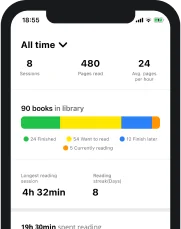As readers, we go through a lot of stages on our journey to becoming as effective and well-performing as possible. From the day we start identifying letters as children, we begin a wonderful journey filled with learning, mental development, and constant improvement of our skills. Our vocabularies start developing as we start learning new words and understand their meaning, and our reading fluency improves from one day to another.
While achieving a certain level of fluency in reading is an important milestone in our education that we are pushed towards in school, very few people have a good understanding of what reading fluency is and why it is important.
Here at Basmo, we are not only dedicated to helping you find the beauty in reading, but we also want to provide you with all the relevant information about the reading components that will allow you to constantly improve your skills and performance. That is why we dedicated significant resources to finding out everything there is to know about reading fluency, the best tips and tricks on developing reading fluency, and the most relevant goals you should have in regard to it.
Before we start exploring the best strategies to improve reading fluency, the most important thing is to have a good understanding of the concept.
What is reading fluency?
The reading fluency definition states that it represents one’s ability to read with proper speed and accuracy, articulate the words and phrases correctly as they go, and use the correct intonation and expression.
It includes two different aspects which are equally important: oral reading fluency and silent reading fluency. While the two refer basically to the same skill when we get down to their essence, the differentiation is done by the linguistic aspect.
What is oral reading fluency?
Oral reading fluency refers to the skill of reading aloud at a constant and natural rate, without noticeable effort, making the text sound like normal speech using the correct intonation, expression, and enunciation.
A person with good oral reading fluency won’t need to pause in the middle of sentences, won’t make pronunciation mistakes while reading, and will bring the text to life with correct and natural intonation. The text is going to be read aloud at a natural and constant speed and will be easy to follow and comprehend.
What is silent reading fluency?
The skill of reading silently with good fluency represents the ability to read internally with a good speed, without the need to pause mid-sentence, to internally reproduce the sounds of the words, the correct phrasing, and intonation, and to comprehend the text with little or no effort.
Silent reading fluency refers to the same ability as oral reading flyency, but on an internal level.
Why is reading fluency important?
The importance of reading fluently goes well beyond getting good grades in primary school. Reading fluency is considered to build a bridge between recognizing words and comprehending them. People with good fluency, whether we are referring to oral or silent fluency, easily read at a decent speed, which gives them enough time to also process, decode, and understand the text at the same time. They recognize words with a certain level of automatism, allowing their brain to add meaning to the words and phrases they read, which makes adding intonation and expression to the reading material a lot easier and more accurate.
Reading fluency also has a direct impact on reading speed. A person with a below-average fluency will have a much lower reading speed, which in turn will mean that they will get a lot less reading done in the allocated time. This comes with a domino effect that seriously affects the reading performance in the long run. Sub-par fluency means low reading speed, which means less reading done, which leads to slower-developing vocabulary, which later develops into more serious educational issues.
Since reading fluency goes hand in hand with comprehension, its importance is, without a doubt, not to be ignored. While comprehension is clearly relevant in the reading process, enjoying the time spent reading is equally important. Reading fluency has a very powerful influence on how enjoyable our reading sessions are.
If we’re struggling to read fluently and the activity doesn’t go smoothly and effortlessly, we are quite unlikely to see the beauty in it and reach the level where we actually enjoy what we are reading. This also has a major impact on our reading habits, as it’s well known that we are prone to doing the things we love more often than the things we cannot find any joy in.
What are the 3 components of reading fluency?
Reading fluency can also be defined through its three main components. There are three aspects of reading that work together to determine the actual reading fluency of a person:
- Accuracy.
- Rate.
- Intonation (otherwise referred to as prosody or expression).
Let’s take them one by one and see what their importance is.
1. Reading accuracy
Whether we are referring to the ability to read out loud or to recognize words when reading internally, your reading accuracy plays a huge role in your ability to develop good reading fluency.
The accuracy aspect refers to a reader’s ability to read the written words correctly and effortlessly. This ability is gained slowly as we learn to read and improve on this skill. Reading correctly comes as a result of practice.
Our brain learns how to interpret the letters organized in words and sentences, and later starts doing it with a certain level of automatism. Developing this ease to quickly and effortlessly decode the written words is what will eventually lead to good reading accuracy, which is a tremendously important building block for your reading fluency.
Without the ability to accurately read and comprehend the meaning of words, your reading speed and fluency are going to suffer tremendously. That’s because accuracy is what will allow you to get everything right on the first try and will help you do your reading effortlessly.
2. Reading rate
The rate at which reading is done can play a huge role in the experience. Probably the most important thing to factor in is the fact that slow reading has a negative impact on comprehension. Reading at speeds of 50-70 words per minute has been found to limit how much a person actually understands while reading. As you already know, comprehension and reading fluency go hand in hand and you can’t have one without the other.
Reading with a level of automaticity and effortlessness is required for good fluency because it allows the reader to focus more on the meaning of the words than on actually reading them. Easily identifying words automatically will allow you to understand what you are reading quicker, which will leave you more time to interpret the text and use that for choosing the right intonation.
3. Prosody
Completely dependent on rate and accuracy, the third component of reading fluency is prosody. This refers to using the right intonation, tone, rhythm, accents, and pauses while reading the text. To be able to use the right prosody when reading a text, people need to have a good reading rate and a level of automatism in recognizing and understanding words.
Intonation and comprehension are strongly connected through a two-way effect: a good level of comprehension allows people to read with good intonation by allowing them to break the text into meaningful semantic and syntactic constructions and add meaning to them, and reading with correct prosody increases the amount of information people are able to understand while reading both internally and out loud.
How to improve reading fluency?
Improving reading fluency is a process that generally starts in the early years of elementary school. Whether you are worried about your child’s reading fluency skills or your own, the good news is that there are still things you can do. Here are a couple of things we found to be very useful for your reading fluency goals, regardless of what those might be.
Practice
The most important thing to do if you feel your own or your child’s reading fluency is not at the level it should be is to practice. Developing the automatisms required for good reading fluency takes time and requires a very repetitive process. The more you read, the better your brain will learn how to do it and will start requiring less mental effort to complete the reading tasks. Comprehension is going to improve as well, and your reading speed will slowly and steadily increase. Practice makes perfect.
Getting into the habit of reading with a clear purpose to improve your reading fluency can be challenging, but Basmo is here to help. Basmo is a reading tracking app that will help you take your reading to a completely different level.
For starters, Basmo will allow you to add structure to your reading habits, which is going to massively improve your overall performance in time. To benefit from this, you will be able to create a reading schedule. That way, you will be able to read for a predetermined period of time every day.
The scheduling feature from the Basmo app will allow you to choose the days of the week you want your reading sessions to take place, and even different times of day for each session so you can work around your weekly routine.
Basmo also tracks your reading performance. Every reading session is timed and your reading speed is constantly measured. You can easily gain access to important information like your reading speed, the length of your reading sessions, and the number of pages you go through.
You can use this information to track your performance. Since you already know that your reading fluency influences your reading speed, you can easily take your reading speed as an indicator of the progress you make in improving your fluency.
Moreover, Basmo allows you to keep a reading journal or to take notes while reading. You can use these features to keep notes of your reading fluency progress. Write down the information you consider important on this journey and use it to constantly improve.
Use reading fluency strategies
What are the reading fluency strategies? The importance of reading fluency has pushed people to develop several processes through which people can improve their skills of reading with fluency. Even though most of these focus on the development of fluency in children, they can also be easily applied to adults.
These include exercises you can do with a partner, recording yourself as you read to see how you perform, or even timing yourself as you read and giving yourself a limited time to read certain paragraphs.
Use audiobooks
Listening to audiobooks can have a positive effect on your ability to read fluently. Listen carefully, and pay attention to how the words are pronounced, how the voice makes the text come to life, and how important the intonation and phrasing are. Try to mouth the words silently as you listen and constantly try to think of what words are going to come next. This is going to force your brain to fill in blanks in the text, which is going to help tremendously with developing the automatism you will need for good reading fluency.
Final thoughts
Improving your reading fluency can completely change the way you experience your reading sessions. Good reading fluency is going to mean more reading done in your limited time, that you will enjoy your reading a whole lot more, and that you will be able to have a much better level of comprehension. Use Basmo for all your reading needs and you will see how easy everything suddenly becomes.
Give Your Reading Experience
An Extra Boost With Basmo
Track the books you read, monitor the time you spend reading and keep notes on your reading habits and how it makes you feel. You can set yourself targets for the time you spend reading and you can get notified whenever you’re behind on your reading time.
Image by pch.vector on Freepik







